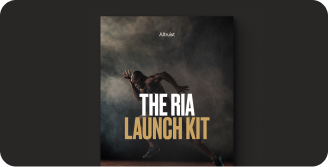An entrepreneur at heart, A.J. Toce’s first business was repairing iPhones. Launched during his college years, the small enterprise led to a big decision: buying his first stock (Apple, of course).
Only a few years out of school, A.J. began advising his first clients, with a single-minded dedication to their financial performance. To truly help more people, however, A.J. knew he’d need more knowledge (and money), so he applied to law school with the idea of learning enough about the law to scale his nascent advisory firm on his own. In between the second and third years of his law program, he launched the business he runs now: Toce Financial Group.
A.J. began his RIA journey with Shareholder Services Group (SSG), and transitioned nearly all of his clients to Altruist in early 2022. Today, Toce Financial Group has over $16M in assets under management (AUM), a number that’s growing steadily (28% YTD at the time we spoke). We sat down with A.J. to hear about becoming an RIA, what it’s been like partnering with Altruist, and what his next entrepreneurial move will be.
Altruist [A]: We always like to start by asking about your path to becoming an RIA. How did it happen? What were the big milestones?
A.J. Toce [AT]: My first exposure to the world of investing came in 2008. My dad lost a chunk of money during the great recession, and I remember him saying, “These financial advisors. If they’re so smart with money, what do they need my money for?” I think that stuck with me—the idea that the right financial advice could make a world of difference. As could the wrong advice!
A: But you didn’t jump into financial advising right away.
AT: No, my first business was actually repairing iPhones in college. What I remember most is how impressive each new device was, and that inspired me to buy my first stock, which was Apple. That was my first real taste of investing.
A: So you first joined an RIA …
AT: After college. It was my first job. I joined a solo operator, and learned a good amount from him. But I also saw that he was charging these crazy fees without delivering superior performance, and that didn’t seem right to me. I ended up buying The Little Book of Common Sense Investing by Jack Bogle, which had a forward in it by Charlie Munger. He said, “Charge no more than 1 percent in fees. That’s what’s fair.” That planted the seed in my mind that I wanted to start my own firm, a firm that would ruthlessly prioritize client financial performance.
A: Which you did a few years later.
AT: Well, first I went to law school. Like Charlie [Munger], I wanted to make money as a lawyer first, then use it to open a shop. I ended up launching Toce Financial in between my second and third years of law school. (I still finished the degree, though.)
A: Talk to us about opening shop.
AT: To start, I had about seven or eight clients who I worked with all through law school. They were the seed of my business, which grew from there. Pretty quickly, though, I ran into some hurdles. The biggest was where to custody assets. To work with any of the big players—TDA, Fidelity, Schwab—I’d need a minimum of $25M in AUM, which was insane. That’s when I realized that the investment industry was not built for smaller shops like mine.
A: That’s how you ended up at SSG.
AT: Right. There, I needed less than $10K in capital to get started. So I kicked off at SSG, with custody at Pershing. And right away I ran into all these other hurdles. There was so much paperwork to fill out for each client, such an enormous regulatory burden, that I honestly felt overwhelmed. I have mild dyslexia, so this kind of work is really tedious for me.
A: You just muscled through it?
AT: I mean, I didn’t have a choice. I dealt with the headaches, and we grew—by 2020, we were up to about 100 clients and $7M in AUM.
A: So then, how did you hear about Altruist?
AT: I’m not exactly sure where it was, but I saw a screenshot of the RIA dashboard, and I remember thinking, “Wow, that looks clean. Let me take a look at that.”
A: Our design team will be thrilled to hear that.
AT: For sure. This would have been, I guess, early 2022. I remember researching Altruist, learning about how simple everything is, how easy it is to sign up and get through paperwork—it looked like Altruist had streamlined all of the administrative things that were causing me such a headache. And my next reaction was, “This seems too good to be true.” But I thought, let’s give it a try, so I moved a few clients over, and it turned out Altruist was every bit as good as you said it was.
A: That’s why we do it. How is running your shop different now that you’re with Altruist?
AT: The other day, I was on the phone with a client who had recently come into a large sum of money. She just wanted to get it invested so it wasn’t weighing on her. In fifty-nine minutes, I had all of her accounts transferred to Altruist, her money invested, and everything else set up. Anywhere else, that would have been three meetings over multiple days, a bunch of physical paperwork—at Altruist, it took less than an hour. I turned to one of my colleagues and said, “I wonder if she realizes how incredible that was.”
A: Faster onboarding. Definitely.
AT: After that, it’s the tools and dashboards, the integrations. Things like RightCapital, I use that all the time. Before Altruist I was making manual trades for each client. Now, I can automate that, I can create model portfolios for each client and make sure that their money moves the way that it’s supposed to, that I’m not a bottleneck. What that’s actually doing is making sure that I can treat the really small accounts exactly the same as the big ones, which is how I want it.
A: As you know, SSG is now part of Altruist. You’ve made the transition, and it sounds like it’s going well. What else would you share with fellow SSG advisors?
AT: Overall, I’m extremely satisfied. Altruist offers everything I need to run my business, plus things I didn’t even know I wanted. Like, no other custodian sends out materials that I can share with my end clients, explaining a particular product or feature. Altruist is actually helping me deepen relationships with my existing clients and bring new clients in.
A: We appreciate the feedback. We’re here to deliver exactly that kind of service to RIAs. Okay, finally, what’s next for you?
AT: I’m a lawyer, so the next big step for Toce Financial is to get all of our clients signed up for estate planning. As the financial advisor, we already have most of the information we’d need, and it would just be a small fee on top of that to get your will and estate squared away. It’s another way for people to secure their financial future, which is what we’re all about.
—
Run an RIA? Want to cut down on onboarding time, and gain access to dashboards and tools that will streamline your business? Learn more here.















